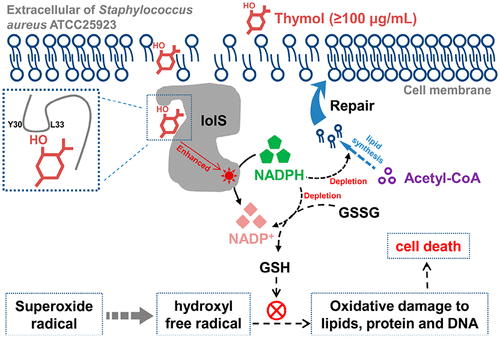当前位置:
X-MOL 学术
›
J. Agric. Food Chem.
›
论文详情
Our official English website, www.x-mol.net, welcomes your
feedback! (Note: you will need to create a separate account there.)
Thymol Mediates Bactericidal Activity against Staphylococcus aureus by Targeting an Aldo–Keto Reductase and Consequent Depletion of NADPH
Journal of Agricultural and Food Chemistry ( IF 5.7 ) Pub Date : 2019-07-04 00:00:00 , DOI: 10.1021/acs.jafc.9b03517 Wei Zhou 1 , Zhen Wang 1 , Haizhen Mo 1 , Yanyan Zhao 1 , Hongbo Li 1 , Hao Zhang 1 , Liangbin Hu 1 , Xiaohui Zhou 2
Journal of Agricultural and Food Chemistry ( IF 5.7 ) Pub Date : 2019-07-04 00:00:00 , DOI: 10.1021/acs.jafc.9b03517 Wei Zhou 1 , Zhen Wang 1 , Haizhen Mo 1 , Yanyan Zhao 1 , Hongbo Li 1 , Hao Zhang 1 , Liangbin Hu 1 , Xiaohui Zhou 2
Affiliation

|
Staphylococcus aureus is a common pathogen that can cause life-threatening infections. Treatment of antibiotic-resistant S. aureus infection needs effective antibacterial agents. Thymol, a generally recognized safe natural compound, has potential as an alternative to treat S. aureus infections. However, the targets and mechanisms of action of thymol were not fully understood. Bioinformatics analysis showed that IolS, a predicted aldo–keto reductase (AKR) in S. aureus, could be a potential target of thymol. Isothermal titration calorimetry (ITC) analysis demonstrated that thymol directly binds IolS and amino acid residues (Y30 and L33) are essential for such binding. Deletion of IolS or mutation of Y30A and L33A reduced the bactericidal activity of thymol at the concentration of 200 μg/mL, suggesting that thymol mediates bactericidal activity via binding with IolS. Biochemical analysis showed that addition of thymol significantly increased AKR activity of IolS from 1.6 ± 0.1 to 2.4 ± 0.2 U (p < 0.05). The content of NADPH within S. aureus cells decreased significantly from 105 ± 5 to 72 ± 3 pmol/108 cells (p < 0.05) following thymol treatment at the concentration of 200 μg/mL. Importantly, addition of NADPH could alleviate the bactericidal effect of thymol on S. aureus, indicating that the depletion of NADPH is responsible for thymol-mediated bactericidal activity. Overall, these results demonstrated that thymol could directly bind IolS and increase its AKR activity, leading to the depletion of NADPH and bactericidal effect. AKR activity of IolS could be a promising target for the development of new antimicrobials.
中文翻译:

百里香酚通过靶向Aldo-酮基还原酶和随之而来的NADPH消耗来介导对金黄色葡萄球菌的杀菌活性。
金黄色葡萄球菌是一种常见的病原体,可导致威胁生命的感染。抗生素耐药的金黄色葡萄球菌感染的治疗需要有效的抗菌剂。百里酚,一种公认的安全天然化合物,具有治疗金黄色葡萄球菌感染的潜力。但是,百里酚的靶标和作用机理尚未完全了解。生物信息学分析表明,IolS是金黄色葡萄球菌中的一种预测的醛酮还原酶(AKR),可能是百里酚的潜在目标。等温滴定热法(ITC)分析表明,百里酚直接结合IolS,氨基酸残基(Y30和L33)对于这种结合必不可少。IolS的缺失或Y30A和L33A的突变会降低百里酚在200μg/ mL浓度下的杀菌活性,这表明百里酚通过与IolS结合介导杀菌活性。生化分析表明,百里香酚的添加显着提高了IolS的AKR活性,从1.6±0.1增至2.4±0.2 U(p <0.05)。金黄色葡萄球菌细胞中NADPH的含量从105±5降至72±3 pmol / 10 8细胞(p<0.05)百里酚处理后浓度为200μg/ mL。重要的是,添加NADPH可以减轻百里酚对金黄色葡萄球菌的杀菌作用,这表明NADPH的消耗与百里酚介导的杀菌活性有关。总体而言,这些结果表明百里酚可以直接结合IolS并增加其AKR活性,从而导致NADPH的消耗和杀菌作用。IolS的AKR活性可能是开发新抗微生物药物的有希望的目标。
更新日期:2019-07-04
中文翻译:

百里香酚通过靶向Aldo-酮基还原酶和随之而来的NADPH消耗来介导对金黄色葡萄球菌的杀菌活性。
金黄色葡萄球菌是一种常见的病原体,可导致威胁生命的感染。抗生素耐药的金黄色葡萄球菌感染的治疗需要有效的抗菌剂。百里酚,一种公认的安全天然化合物,具有治疗金黄色葡萄球菌感染的潜力。但是,百里酚的靶标和作用机理尚未完全了解。生物信息学分析表明,IolS是金黄色葡萄球菌中的一种预测的醛酮还原酶(AKR),可能是百里酚的潜在目标。等温滴定热法(ITC)分析表明,百里酚直接结合IolS,氨基酸残基(Y30和L33)对于这种结合必不可少。IolS的缺失或Y30A和L33A的突变会降低百里酚在200μg/ mL浓度下的杀菌活性,这表明百里酚通过与IolS结合介导杀菌活性。生化分析表明,百里香酚的添加显着提高了IolS的AKR活性,从1.6±0.1增至2.4±0.2 U(p <0.05)。金黄色葡萄球菌细胞中NADPH的含量从105±5降至72±3 pmol / 10 8细胞(p<0.05)百里酚处理后浓度为200μg/ mL。重要的是,添加NADPH可以减轻百里酚对金黄色葡萄球菌的杀菌作用,这表明NADPH的消耗与百里酚介导的杀菌活性有关。总体而言,这些结果表明百里酚可以直接结合IolS并增加其AKR活性,从而导致NADPH的消耗和杀菌作用。IolS的AKR活性可能是开发新抗微生物药物的有希望的目标。

































 京公网安备 11010802027423号
京公网安备 11010802027423号